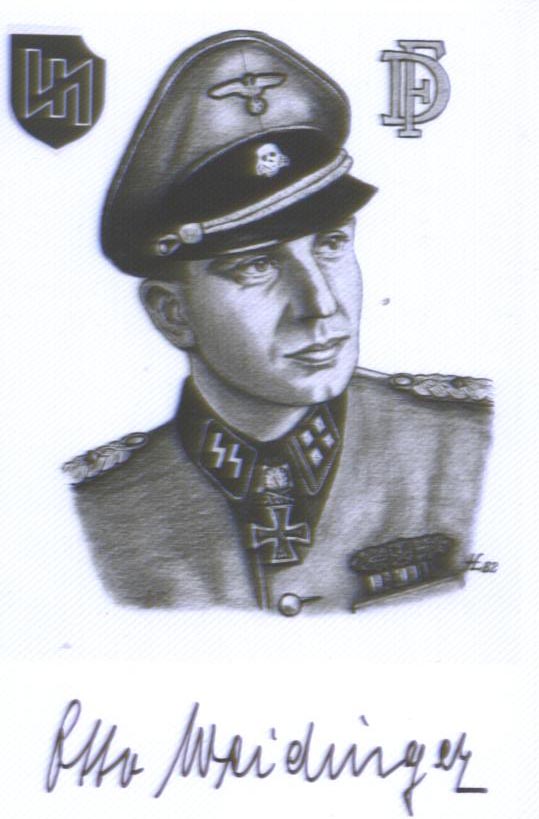
|
~SOLD~ WEIDINGER Otto
WEIDINGER Otto
Obersturmbannfuhrer
Awarded Knights Cross April 21,1944 as Sturmbannfuhrer and CO of the -Recon Bn.,2nd Pz.Div."Das Reich", Russian Front
Awarded Oakleaves Dec 26,1944 as Obersturmbannfuhrer and CO of the 4th-Pz.Gren.Rgt. "Der Fuhrer",2nd Pz. Div."Das Reich"
Awarded Swords May 6, 1945 by the Commanding General, 6th Pz.Army, Southeastern Front.
Postwar signed photo measuring 3 ¾” x 5 ¾” Desirable autograph of a Swords winner division commander
With the Division Das Reich, he participate in the invasion of Poland and in the Battle of the Netherlands. In 1939, Weidinger served as adjutant of a reconnaissance battalion during the invasion of Poland, earning his first medal. Following a training course, he was promoted to company commander in the spring of 1940.
During Operation Barbarossa, the invasion of the Soviet Union, during the invasion of Russia, Weidinger was made commander of No. 3 Company of the Das Reich Division. The company was heavily committed against a superior enemy along 14 kilometers of the front. Weidinger’s first action commanding the company was a successful counterattack against Soviet forces pouring through the broken line. He drove them back and sealed the breach. Following a stint as an instructor, Weidinger returned to the Russian front in time for Operation Citadel, the German attempt to destroy the Russians in the Kursk salient Weidinger’s battalion led the way in the Deutschland regiment’s attack against some of the toughest Russian positions. Moving out under cover of darkness, they captured Russian outposts protecting an anti-tank ditch at Jakantov, opening the way for their comrades.
After the failed Kursk offensive, Weidinger was given command of a reconnaissance battalion. During the following months, he faced the toughest fighting of his career, as the massed Soviet armies pushed back against the invaders. Calm under fire, he trained his men to stay down in their trenches until Russian tanks had rolled over them, then emerge to fight the enemy, counting on more heavily armed troops to deal with the tanks. In March 1944, Weidinger was made commander of his own battle group. They were moved to France, where they became part of the forces countering the Allied invasion in June.
The broken terrain of the Normandy bocage, which suited other commanders, caused Weidinger problems. Reduced visibility disrupted fields of fire. He could see so little that he could not directly control many of his troops.
His troops took heavy losses in offensives against the Allies, including one which was called off by more senior commanders even as Weidinger’s men advanced into an artillery barrage. When a large group of German troops was encircled around Falaise, Weidinger was among the forces ordered to break the encirclement.
His personal example as a leader kept his men going even as exhaustion threatened to disrupt their advances. They defeated a Polish tank force, pushed back Allied forces, and captured Mount St Leger. From the high ground, their fire dominated the surrounding area, breaking the encirclement.
The remains of the German army escaped through the gap and began a fighting retreat toward Germany. Shortly after the Bulge, he was moved east, to fight the advancing Soviet forces.
American tanks move through fog at the Bulge.
Das Reich, Weidinger’s parent division, struggled to defend the Hungarian oilfields, on which the Reich depended for fuel. When they failed, they retreated into Austria to defend the capital, Vienna. By April 14, it too had to be abandoned, and they withdrew across the Danube.
Das Reich continued to fight on the eastern front, as individual battle groups instead of a single formation. Weidinger and his men were sent to Czechoslovakia, where he carried out his last operation of the war. When a revolt broke out in Prague, Elite forces there became trapped. Given that the Germans had performed atrocities in Czechoslovakia, those Germans feared reprisals if the Czechs or Soviets captured them. On May 6, Weidinger and his group set out to rescue them.
In the suburbs of Prague, they encountered a huge roadblock made of cobblestones and had to work late into the night clearing the road. At the Troya bridge, they came under fire from small-arms and halted until daylight, rather than risk hitting civilians in the dying days of the war. The next day, they took the bridge and also ground on the other side.
Following negotiations, the locals agreed to let Weidinger take the Germans out of Prague. As more Germans appeared seeking safety, a column of 1000 lorries formed and rolled out of the city. They reached the American lines, where Weidinger disbanded his unit and surrendered.
When World War II ended, Weidinger was held at the Dachau internment camp administered by the US Army. In August 1947, he was transferred to French custody, where he was charged with war crimes and stood trial in 1951. Weidinger was acquitted by a military court in Bordeaux in June 1951. At the trial of the perpetrators of the Oradour-sur-Glane massacre in Bordeaux in January 1953, Weidinger was a witness for the defense.
Price: $0.00
Please contact us before ordering to confirm availability and shipping costs.
Buy now with your credit card
other ways to buy
|


